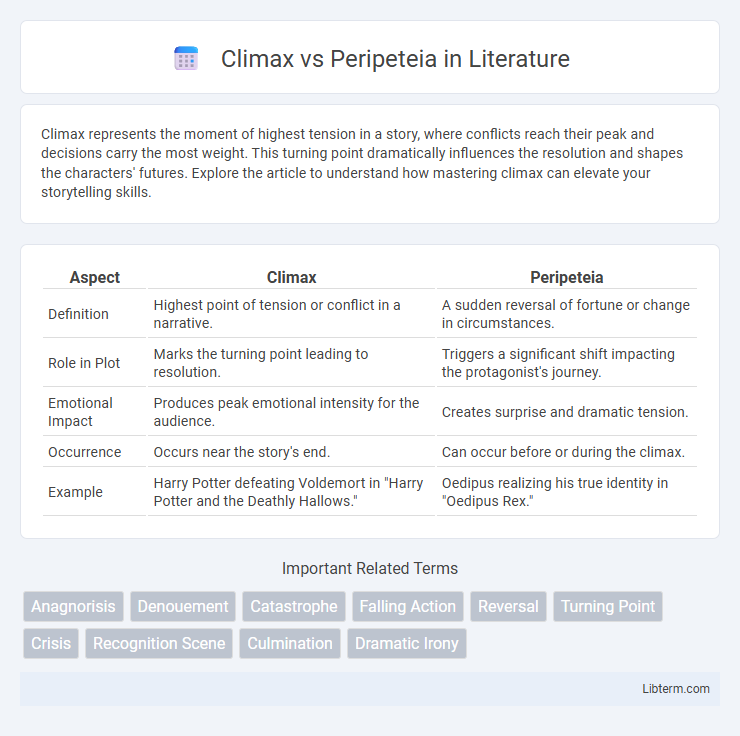Climax represents the moment of highest tension in a story, where conflicts reach their peak and decisions carry the most weight. This turning point dramatically influences the resolution and shapes the characters' futures. Explore the article to understand how mastering climax can elevate your storytelling skills.
Table of Comparison
| Aspect | Climax | Peripeteia |
|---|---|---|
| Definition | Highest point of tension or conflict in a narrative. | A sudden reversal of fortune or change in circumstances. |
| Role in Plot | Marks the turning point leading to resolution. | Triggers a significant shift impacting the protagonist's journey. |
| Emotional Impact | Produces peak emotional intensity for the audience. | Creates surprise and dramatic tension. |
| Occurrence | Occurs near the story's end. | Can occur before or during the climax. |
| Example | Harry Potter defeating Voldemort in "Harry Potter and the Deathly Hallows." | Oedipus realizing his true identity in "Oedipus Rex." |
Understanding Climax: Definition and Importance
Climax represents the highest point of tension or conflict in a narrative, where the protagonist faces a decisive moment that determines the story's outcome. Its importance lies in creating emotional engagement and driving the plot toward resolution, making it essential for narrative structure. Unlike peripeteia, which involves a sudden reversal of fortune, climax is the peak intensity that shapes the story's ultimate direction.
What is Peripeteia? A Literary Overview
Peripeteia refers to a sudden reversal of fortune or change in circumstances within a narrative, often leading to a shift in the protagonist's fate. It is a crucial element in classical tragedy, famously analyzed in Aristotle's *Poetics*, where peripeteia triggers the transition from stability to chaos. Unlike the climax, which is the story's peak of tension or conflict, peripeteia specifically marks the turning point that alters the direction of the plot, driving forward the resolution.
Key Differences Between Climax and Peripeteia
Climax represents the highest point of tension and decisive action in a narrative, marking the moment when the protagonist faces their greatest challenge. Peripeteia, in contrast, refers to a sudden reversal of fortune or change in circumstances that shifts the direction of the story, often turning success into failure or vice versa. The key difference lies in climax being the peak of dramatic intensity, while peripeteia is the plot twist that triggers a fundamental change in the protagonist's fate.
Historical Origins of Climax and Peripeteia
Climax, deriving from ancient Greek rhetoric, was first formalized by Aristotle as the emotional high point in drama designed to captivate audiences and resolve narrative tension. Peripeteia originated in Aristotle's *Poetics* as a sudden reversal of fortune that fundamentally shifts the protagonist's circumstances, often from stability to disaster, enhancing the tragic impact. Both concepts have influenced storytelling since classical antiquity, shaping Western literary tradition by structuring plot and emotional progression through strategic turning points.
Climax in Classic vs Modern Literature
The climax in classic literature typically serves as the highest point of tension where the protagonist faces a decisive confrontation, often resolving the central conflict with clear moral implications. In modern literature, the climax frequently embraces ambiguity, emphasizing psychological complexity and internal conflict rather than definitive outcomes. This shift reflects evolving narrative structures and a focus on character depth over traditional plot resolutions.
Peripeteia: Tragedy’s Turning Point
Peripeteia represents the crucial turning point in tragedy where the protagonist's fortune reverses, propelling the narrative toward its inevitable downfall. This moment creates intense emotional impact by shifting the plot's direction, often from success to failure, thereby heightening dramatic tension. Unlike climax which signals peak action or decision, peripeteia encapsulates the sudden reversal that defines classical tragic structure in works like Sophocles' "Oedipus Rex.
Examples of Climax in Famous Works
The climax, the story's highest tension point, appears in Shakespeare's "Macbeth" during Macbeth's murder of King Duncan, signifying his irreversible descent into tyranny. In "Romeo and Juliet," the climax occurs when Romeo kills Tybalt, escalating the feud between the Montagues and Capulets and sealing the lovers' tragic fate. Similarly, in "The Great Gatsby," the climax is Gatsby's confrontation with Tom Buchanan, which leads to the unraveling of Gatsby's dreams and his ultimate demise.
Peripeteia Illustrated: Notable Literary Moments
Peripeteia, a crucial plot reversal in classical literature, dramatically shifts a character's fortune from good to ill or vice versa, as famously illustrated in Sophocles' "Oedipus Rex" when Oedipus discovers his true identity. This narrative device creates tension and surprise without needing to mark the narrative peak, distinguishing it from the climax. Shakespeare's "Macbeth" provides another notable example when Macbeth shifts from a confident king to a desperate tyrant after the witches' prophecies, exemplifying peripeteia's power to alter the story's direction and character fate.
Narrative Structure: Placing Climax and Peripeteia
Climax represents the highest point of tension or conflict in a narrative's structure, often marking the turning point where the protagonist faces their greatest challenge. Peripeteia, a sudden reversal of fortune, occurs typically near or at the climax, reshaping the narrative direction and character fate. In classical and modern storytelling, placing peripeteia strategically enhances the thematic impact of the climax by disrupting expectations and accelerating resolution.
Crafting Stories: When to Use Climax or Peripeteia
Climax serves as the peak moment of tension where the main conflict reaches its highest intensity, ideal for stories that build toward a decisive turning point and resolution. Peripeteia, a sudden reversal of fortune or change in circumstances, is best used to introduce unexpected twists that alter the protagonist's trajectory, heightening emotional impact and thematic depth. Writers choose climax for clear conflict resolution and peripeteia for complexity and surprise, shaping narrative pacing and audience engagement accordingly.
Climax Infographic

 libterm.com
libterm.com